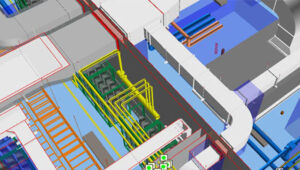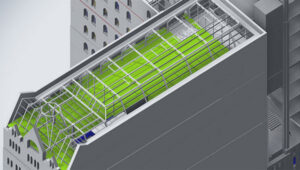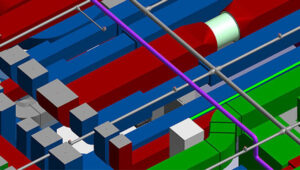The role of a good HVAC BIM service provider is nowadays more important than ever in modern construction projects. With the increasing complexity of building designs and increasing demand for energy-efficient HVAC systems, the right partner is critical. A trusted provider does it accurately, reduces conflict, and improves project coordination with advanced BIM processes. Key elements for provider selection that match your project goals are presented in this article.
1. Experience in HVAC Design Services
Experience is a key influence on provider capability. Experienced HVAC BIM service providers know industry-specific challenges and can deliver solutions that fit your project needs. Here’s why experience matters:
- Understanding Complexity: HVAC systems have ductwork, ventilation, and heating and cooling components. Experienced providers know how to negotiate such challenges and produce functional HVAC 3D Models and designs.
- Portfolio Evidence: Review the provider’s portfolio for examples of completed projects like yours. This can make you confident about their capacity to manage the scope and scale of your project.
- Proven Problem-Solving: Experienced providers have likely encountered and resolved issues that may arise during design or construction and can therefore anticipate problems.
2. Comprehensive BIM Capabilities
A good HVAC 3D Model service provider must have capabilities that cover every aspect of the project. With full BIM capabilities, the provider should handle all phases of the project – from conceptual HVAC 3D Models and designs to construction-ready models.
- Integrated Solutions: This provider would need to be able to develop a fully coordinated BIM model including HVAC, plumbing, and electrical systems. This avoids many clashes and eases the HVAC 3D Model and design implementation.
- Advanced Tools and Software: Check whether the provider uses BIM tools like Autodesk Revit and Navisworks.
- Customization: Maybe your project has unique ductwork layouts or energy-efficient HVAC needs. A good provider will customize his service for you.
3. Adherence to Industry Standards
Complying with industry standards and regulations is the hallmark of a reliable HVAC 3D Model provider. It makes sure that the designs fulfill safety, efficiency, and sustainability benchmarks.
- Global Standards: Search for providers that follow standards such as ISO 19650 for BIM execution, ASHRAE standards for HVAC systems as well as local building codes.
- Quality Control: Providers following such standards perform quality checks at each step of the project so that designs are robust and conformant.
- Sustainability Practices: As the push for green building practices continues your provider should put an earnest effort into energy-efficient HVAC Duct Design Services that comply with environmental law.
4. Strong Communication and Coordination
Projects with several stakeholders need effective communication and coordination. You want your HVAC BIM provider to be a collaborative partner throughout the entire process from the first meeting to the final delivery of the project.
- Stakeholder Collaboration: The provider must work with architects, engineers, and contractors on designs and avoid conflicts.
- Regular Updates: Transparency is key. Providers should give routine progress reports on the project and respond to changes and problems.
- Technology Integration: Tools such as BIM 360 allow for real-time collaboration where reviewers can mark up designs as they develop.
5. Emphasis on Cost Efficiency
A huge consideration is cost but sometimes the cheapest is not the best. Instead, look for the benefit that a provider delivers through quality services and long-term benefits.
- Reduced Rework Costs: A competent provider reduces errors during the initial design phase and costly rework during construction.
- Optimized Resources: Efficient HVAC BIM models save money without compromising quality in material estimation and resource allocation.
- Long-Term Savings: Choosing providers that focus on energy-efficient designs could cut operational costs for HVAC systems in the long haul.
6. Proven Quality Assurance Practices
Without solid QA processes, errors in design could result in expensive delays or rework during construction.
- Clash Detection and Resolution: Advanced providers use Navisworks to identify and resolve model conflicts to ensure proper coordination of HVAC, plumbing, and electrical systems.
- Model Accuracy: Quality assurance protocols include very stringent model checks on dimensions, placements, and system efficiency.
- Adherence to Project Specifications: QA verifies that BIM deliverables are in line with project goals and client expectations.
7. Scalability and Flexibility
Often projects change in design, timeline, or budget. The right HVAC BIM service provider should be flexible enough to handle such changes without sacrificing quality and efficiency.
- Handling Design Changes: Find providers who can incorporate changes quickly in the BIM model without interfering with workflows.
- Project Scaling: Whether it’s one building or a multi-structure development, the provider should be able to scale their services accordingly.
- Dynamic Problem-Solving: Flexible providers can handle unexpected challenges to keep the project moving.
8. Training and Support Services
Even the most sophisticated HVAC BIM models require understanding by the project team. A proven partner offers training & ongoing support so stakeholders can take full advantage of BIM deliverables.
- Tailored Training Programs: Providers should tailor training for their teams to help them navigate the BIM tools.
- Post-Delivery Support: The ongoing support guarantees that issues that come up during implementation or construction are addressed in a timely manner.
- Accessible Resources: Often providers provide some user guide, documentation, or even some online support to help with troubleshooting & maximizing BIM benefits.
9. Data Security Measures
Protecting sensitive project data is nonexistent in age. HVAC Design Services providers handle sensitive project information – data security protocols are critical.
- Encryption Protocols: Get the provider to encrypt data in transit and storage.
- Access Control: Providers should implement role-based access control to limit data exposure to authorized personnel only.
- Compliance with Data Regulations: Check if data protection laws such as GDPR or CCPA are followed by the provider – especially for projects with international stakeholders.
10. Positive Client Feedback and Reputation
The reputation of an HVAC Design Services provider says reliability and professionalism. Client testimonials, Reviews & Case Studies from actual clients are also a great way to know about their capabilities.
- Consistent Positive Reviews: Search for providers that have satisfied clients with good feedback about the service.
- Case Studies: Providers that share detailed case studies show transparency and believe they can deliver results.
- Long-Term Partnerships: A strong reputation can result in repeat business and more long-term relations indicating trust and dependability.
Conclusion: Finding the Ideal HVAC Design Services Provider
Finding the right HVAC BIM service provider is more than technical competence alone. It’s about finding a partner that understands your project vision and can provide dependable, collaborative, and effective solutions. The right provider will improve design accuracy, make workflows easier, and help adhere to industry standards whilst keeping communication clear all through a project.
At SmartCADD, we bring together expertise, technology & quality to provide customized MEP Bim modeling services and solutions for various project needs. Let us help you solve your next HVAC project with precision and efficiency.
FAQS
HVAC BIM (Building Information Modeling) is a digital representation of the HVAC system within a building. It helps in planning, designing, and managing HVAC systems efficiently. It improves accuracy, reduces errors, and enhances collaboration among project teams, ensuring timely and cost-effective project completion.
Key factors include the provider’s experience in HVAC design, proficiency with BIM tools, understanding of your project’s requirements, ability to collaborate effectively, and the quality of customer service. A provider who offers post-project support is also beneficial.
The benefits include improved accuracy in HVAC system design, reduced risks of errors, better project timelines, cost savings through efficient planning, and better collaboration across all teams involved in the project.









